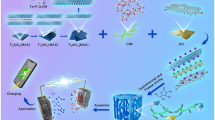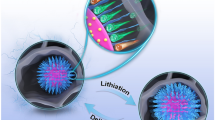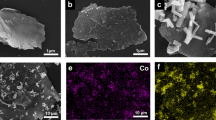Abstract
A facile strategy was developed to prepare interlayer-expanded MoS2/graphene composites through a one-step hydrothermal reaction method. MoS2 nanosheets with several-layer thickness were observed to uniformly grow on the surface of graphene sheets. And the interlayer spacing of MoS2 in the composites was determined to expand to 0.95 nm by ammonium ions intercalation. The MoS2/graphene composites show excellent lithium storage performance as anode materials for Li-ion batteries. Through gathering advantages including expanded interlayers, several-layer thickness, and composited graphene, the composites exhibit reversible capacity of 1030.6 mAh g−1 at the current density of 100 mA g−1 and still retain a high specific capacity of 725.7 mAh g−1 at a higher current density of 1000 mA g−1 after 50 cycles.






Similar content being viewed by others
References
Nishi Y (2001) The development of lithium ion secondary batteries. Chem Rec 1(5):406–413
Kraytsberg A, Ein-Eli Y (2017) A critical review-promises and barriers of conversion electrodes for Li-ion batteries. J Solid State Electrochem 21(7):1907–1923
Li H, Wang Z, Chen L, Huang X (2009) Research on advanced materials for Li-ion batteries. Adv Mater 21(45):4593–4607
Xu X, Liu W, Kim Y, Cho J (2014) Nanostructured transition metal sulfides for lithium ion batteries: progress and challenges. Nano Today 9(5):604–630
Sen UK, Mitra S (2014) Improved electrode fabrication method to enhance performance and stability of MoS2-based lithium-ion battery anode. J Solid State Electrochem 18(10):2701–2708
Zeng Z, Yin Z, Huang X, Li H, He Q, Lu G, Boey F, Zhang H (2011) Single-layer semiconducting nanosheets: high-yield preparation and device fabrication. Angew Chem Int Ed 50(47):11093–11097
Du G, Guo Z, Wang S, Zeng R, Chen Z, Liu H (2010) Superior stability and high capacity of restacked molybdenum disulfide as anode material for lithium ion batteries. Chem Commun 46(7):1106–1108
Rasamani KD, Alimohammadi F, Sun Y (2017) Interlayer-expanded MoS2. Mater Today 20(2):83–91
Guo J, Zhu H, Sun Y, Tang L, Zhang X (2016) Boosting the lithium storage performance of MoS2 with graphene quantum dots. J Mater Chem A 4(13):4783–4789
Xiao J, Choi D, Cosimbescu L, Koech P, Liu J, Lemmon JP (2010) Exfoliated MoS2 nanocomposite as an anode material for lithium ion batteries. Chem Mater 22(16):4522–4524
Wang P p, Sun H, Ji Y, Li W, Wang X (2014) Three-dimensional assembly of single-layered MoS2. Adv Mater 26:964–969
Gao M-R, Xu Y-F, Jiang J, Yu S-H (2013) Nanostructured metal chalcogenides: synthesis, modification, and applications in energy conversion and storage devices. Chem Soc Rev 42(7):2986–3017
Guo Z-Y, Zhong Y, Liu Y, Mao C-M, Li G-C (2017) MoS2 nanosheet arrays supported on hierarchical porous carbon with enhanced lithium storage properties. Chin Chem Lett 28(4):743–747
Mao C, Zhong Y, Shang H, Li C, Guo Z, Li G (2016) Carbon encapsulated nanosheet-assembled MoS2 nanospheres with highly reversible lithium storage. Chem Eng J 304:511–517
Zhong Y, Zhuang Q, Mao C, Xu Z, Guo Z, Li G (2018) Vapor phase sulfurization synthesis of interlayer-expanded MoS2@ C hollow nanospheres as a robust anode material for lithium-ion batteries. J Alloys Compd 745:8–15
Jiang L, Lin B, Li X, Song X, Xia H, Li L, Zeng H (2016) Monolayer MoS2–graphene hybrid aerogels with controllable porosity for lithium-ion batteries with high reversible capacity. ACS Appl Mater Interfaces 8(4):2680–2687
Chang K, Chen W (2011) L-cysteine-assisted synthesis of layered MoS2/graphene composites with excellent electrochemical performances for lithium ion batteries. ACS Nano 5(6):4720–4728
Gong Y, Yang S, Zhan L, Ma L, Vajtai R, Ajayan PM (2014) A bottom-up approach to build 3D architectures from nanosheets for superior lithium storage. Adv Funct Mater 24(1):125–130
Jing Y, Ortiz-Quiles EO, Cabrera CR, Chen Z, Zhou Z (2014) Layer-by-layer hybrids of MoS2 and reduced graphene oxide for lithium ion batteries. Electrochim Acta 147:392–400
Cao X, Shi Y, Shi W, Rui X, Yan Q, Kong J, Zhang H (2013) Preparation of MoS2-coated three-dimensional graphene networks for high-performance anode material in lithium-ion batteries. Small 9(20):3433–3438
Hummers WS Jr, Offeman RE (1958) Preparation of graphitic oxide. J Am Chem Soc 80(6):1339–1339
Dungey KE, Curtis MD, Penner-Hahn JE (1998) Structural characterization and thermal stability of MoS2 intercalation compounds. Chem Mater 10(8):2152–2161
Ong EW, Eckert J, Dotson LA, Glaunsinger WS (1994) Nature of guest species within alkaline earth-ammonia intercalates of titanium disulfide. Chem Mater 6(11):1946–1954
Huang K-J, Wang L, Zhang J-Z, Wang L-L, Mo Y-P (2014) One-step preparation of layered molybdenum disulfide/multi-walled carbon nanotube composites for enhanced performance supercapacitor. Energy 67:234–240
Maugé F, Lamotte J, Nesterenko N, Manoilova O, Tsyganenko A (2001) FT-IR study of surface properties of unsupported MoS2. Catal Today 70(1-3):271–284
Liu S, Zhang X, Shao H, Xu J, Chen F, Feng Y (2012) Preparation of MoS2 nanofibers by electrospinning. Mater Lett 73:223–225
Wang H, Robinson JT, Li X, Dai H (2009) Solvothermal reduction of chemically exfoliated graphene sheets. J Am Chem Soc 131(29):9910–9911
Zhao C, Wang X, Kong J, Ang JM, Lee PS, Liu Z, Lu X (2016) Self-assembly-induced alternately stacked single-layer MoS2 and N-doped graphene: a novel van der Waals heterostructure for lithium-ion batteries. ACS Appl Mater Interfaces 8(3):2372–2379
Anto JA, Nethravathi C, Rajamathi M (2014) Two-dimensional nanosheets and layered hybrids of MoS2 and WS2 through exfoliation of ammoniated MS2 (M= Mo, W). J Phys Chem C 118(2):1386–1396
Wu Z, Tang C, Zhou P, Liu Z, Xu Y, Wang D, Fang B (2015) Enhanced hydrogen evolution catalysis from osmotically swollen ammoniated MoS2. J Mater Chem A 3(24):13050–13056
Chen J, Sheng K, Luo P, Li C, Shi G (2012) Graphene hydrogels deposited in nickel foams for high-rate electrochemical capacitors. Adv Mater 24(33):4569–4573
Li H, Yu K, Fu H, Guo B, Lei X, Zhu Z (2015) MoS2/graphene hybrid nanoflowers with enhanced electrochemical performances as anode for lithium-ion batteries. J Phys Chem C 119(14):7959–7968
Chao Y, Jalili R, Ge Y, Wang C, Zheng T, Shu K, Wallace GG (2017) Self-assembly of flexible free-standing 3D porous MoS2-reduced graphene oxide structure for high-performance lithium-ion batteries. Adv Funct Mater 27(22). https://doi.org/10.1002/adfm.201700234
Wang S, Tu J, Yuan Y, Ma R, Jiao S (2016) Sodium modified molybdenum sulfide via molten salt electrolysis as an anode material for high performance sodium-ion batteries. Phys Chem Chem Phys 18(4):3204–3213
Zhen M, Zhen X, Liu L (2017) Mesoporous nanoplate TiO2/reduced graphene oxide composites with enhanced lithium storage properties. Mater Lett 193:150–153
Xu X, Fan Z, Yu X, Ding S, Yu D, Lou XWD (2014) A nanosheets-on-channel architecture constructed from MoS2 and CMK-3 for high-capacity and long-cycle-life lithium storage. Adv Energy Mater 4(17). https://doi.org/10.1002/aenm.201400902
Funding
This work was supported by the National Natural Science Foundation of China (NSFC 21571170, 21501168, 21701124, and 51702236) and Postdoctoral Science Foundation of China (2017M611171).
Author information
Authors and Affiliations
Corresponding authors
Electronic supplementary material
ESM 1
(DOCX 889 kb)
Rights and permissions
About this article
Cite this article
Wang, Y., Zhen, M., Liu, H. et al. Interlayer-expanded MoS2/graphene composites as anode materials for high-performance lithium-ion batteries. J Solid State Electrochem 22, 3069–3076 (2018). https://doi.org/10.1007/s10008-018-4018-8
Received:
Revised:
Accepted:
Published:
Issue Date:
DOI: https://doi.org/10.1007/s10008-018-4018-8




